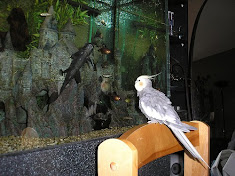 |
| Schimmel Gerbil Trio by Ben McKune |
Other small animals and their drawbacks
I suppose before I assume your little critters will want one of the furry and cuddly variety, I should address the cold-blooded sort. Personally I like snakes and lizards well enough, but I wouldn't necessarily want one living in my house. Also, young children are very tactile and many of these creatures need to be handled carefully or don't necessarily like to be handled at all. Beyond that, their set-up can be expensive and difficult to maintain. As reptiles can't regulate their own body temperatures it is crucial that their domiciles are maintained at a certain constant temperature. Their diets can also be tricky. For these reasons it is very easy for them to fall ill if not watched closely for signs of distress.
Now onto our fluffy friends. Bunnies are some of the cutest animals around but experts will tell you that they are not good pets for young children. They are prone to biting, even with a lot of gentle handling and "training" to get them used to being pet and cuddled. Of even greater concern is the fact that they are a lot more fragile than they look. Rabbits have very delicate bones and even older children and adults need to be conscious of how they pick them up, handle them, and replace them to their homes. They also need a lot of care, and can be a lot of work to clean up after to keep their cages neat and odor-free.
Guinea pigs have a lot of the same pitfalls as bunnies. Though they actually need a lot of love and attention which may seem like a match made in heaven for kids who want nothing more than to bestow hugs and kisses upon them, it's a lot more work than one would think. If you have one guinea pig, you must spend at least a couple of hours a day taking it out of its home and playing with it. If you have two (highly recommended as they are very social and get lonely), they still need to be taken out of their cage at least once a day for an hour or more for play time. They also require a lot of different toys to play with and places to hide and explore to keep them happy and healthy. Once again diet is crucial and clean-up can be a job unto itself. The benefits are well worth it - ask any guinea pig lover - but that's a lot of work for anyone.
Rats (if they don't creep you out) are very social but the downside once again is that they require a lot of attention and care. Mice are great but they are lightning-fast, pee a lot, and need a lot of things to climb and play on to be happy. They are a great option though, as they are easy to care for in terms of diet, don't require a lot of attention from you if they are kept in pairs or groups, and don't require a large cage. And, the more you give them to play with, the more entertaining they become. I would definitely rank them in the number two spot.
Hamsters, though one of the cutest little critters around, aren't all that easy to take care of. Diet is simple, and again they don't require a large cage (though with any animal the more space you can give it, the happier it will be). They do however need to be trained to be held without freaking out or biting, they are fragile, and they pee a lot too which means their bedding needs to be changed regularly. There are also different types of hamsters and each type has different requirements to be healthy and happy. Some can and should be housed in multiples, others need to be solitary, like Teddy Bear hamsters. And though this should be intuitive and applies to any pets you may have, don't house both sexes together or you will end up with more pets than you bargained for. Hamsters (any type) would be better for a slightly older child with a little more patience.
 |
| What's For Dinner? by hinayana |
We now come to gerbils. They should be housed in groups of at least two or more females to keep them happy as they are very social little munchkins. They are fast but they won't bite and they can be trained easily to get used to being held. They don't seem to mind too much if a child comes along, startles them, and scoops them up without warning. The only time a gerbil has even so much as nibbled on my finger was when I forgot to wash my hands after making a peanut butter-and-jam sandwich - who could blame the little guy?
Gerbils are desert creatures which means they drink less water than other furry animals and thus they pee far less. This means their bedding stays cleaner longer and they should never have a smelly cage for you to deal with. They also love to dig and burrow but introduce a wheel into their environment and once they figure it out it will be their new favorite toy!
Their diet is simple (you can buy a two-kilo bag of gerbil food at your nearest Walmart for $4.00 and it will last two gerbils quite a while) and so is their home set-up. The only thing I recommend you don't do is buy one of those Habitrail hard-plastic homes for them. They love to chew and will make cracks in the plastic eventually, but this doesn't mean they are difficult to house. You may like the look of the store-bought sanctuary but trust me, they don't care. All they want to do all day is burrow and run on their wheel, and maybe box a little - this is typical of gerbils, especially sisters like the gerbils I have, Lola and Yvette. They may squeak and fight but so long as they cuddle up together at bedtime, you know they're fine.
I bought my little duo the biggest Rubbermaid container I could find, filled it with recycled cardboard bedding (also available at Walmart and pet stores of course) - as wood chip bedding is not safe or healthy for any animal as it can cause respiratory issues - a wheel, a $5 wooden hut, food, and a water bottle and they're in hog heaven. They live an average of one to 3 years and mine have already passed the 3-year mark!
A reminder - lots of space is key to your new pet's welfare
As an animal lover I am a huge advocate of making sure you do all of your research before adopting a pet of any kind. This is essential to ensure that everything from their bedding to their food and home set-up is appropriate and of the highest quality.
Another crucial issue is space. Commercial cages aren't that big and pet store "experts" will be only too happy to direct you to a cage with all of the bells and whistles and convince you that this will keep your new pet happy, but this is not the case. Again, if you do your research you will find that commercial cages are made to be big enough to house the appropriate animals and give them room to move around a bit, but that doesn't mean they're adequate by any stretch of the imagination.
Imagine if someone had you in a cage for almost twenty-four hours a day. The issue is that manufacturers need to make cages that are easy to ship, can be easily stacked once they reach the pet store, and can be sold at an outrageous mark-up for what is little more than heavy wire and/or plastic. Down the road when the kids are older and you decide you may want to graduate to one of the animals I have mentioned, have a look online for easy and inexpensive DIY pet homes. It if often more fun to design and create your own habitat and this way your pet will have all the room it needs and then some. This will be evident in its behaviour and you'll all reap the benefits of a happy, healthy, and playful new addition to your family.
Author Resource
Written by Ardra Taylor
Article Source: http://EzineArticles.com/?expert=Ardra_Taylor
http://EzineArticles.com/?Gerbils---The-Best-Pet-Option-for-Young-Children&id=5327941



0 comments:
Post a Comment